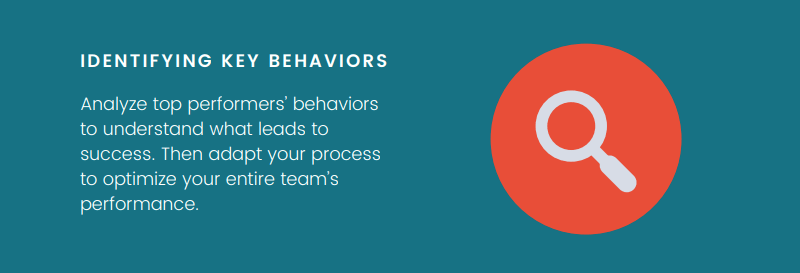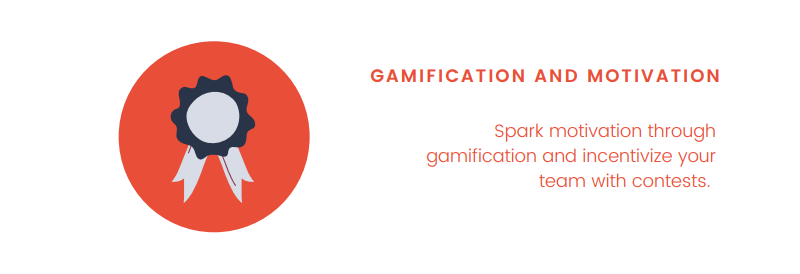Sales Performance Management is a set of processes that optimize the measurement, analysis and development of sales input & output. The main objective is to improve salesperson performance and drive successful business outcomes.
Sales Performance Management is made up of multiple elements that drive successful business results. These include:
An effective Sales Performance Management strategy puts the focus on your people. It comes from the belief that improving quality is a better approach than simply increasing quantity or headcount.
It looks different for nearly every organization, because each has their own process. However, they all revolve around the same idea: better processes = better outcomes.
Perhaps the most critical element of a Sales Performance Management strategy is visibility, because if you can’t see what your sales team is doing, you can’t make improvements.
If you want to ensure quality, you need a way to monitor your sales team’s performance toward their goals.
There are two parts to improving quality and performance:
First, you can only identify a problem if you have visibility into what your sales reps are doing, i.e. sales activities. It is imperative that you monitor and measure important metrics and Key Performance Indicators.
The metrics you need to be measuring, according to Jason Jordan’s authoritative book on the subject of sales management, are categorized as Sales Activities, Sales Objectives, and Business Results. When you have the ability to monitor these metrics in real-time, you can course-correct sooner.

Second, the only way you can know what leads to success is to analyze the activities and tactics of top performers to surface actionable insights. You need to pinpoint what it is they have done differently than everyone else to achieve higher success.
Usually, a combination of your CRM + Sales Performance Management software is the most effective way to accomplish this.
Your CRM will track the individual activities and activity-level metrics, and can spit out a report with a massive amount of data. But pulling that report can take time and involve complex set up, not to mention the difficulty digesting that much data.
That’s where the Sales Performance Management software helps you optimize the process with scorecards and leaderboards.
Scorecards visualize data and provide an instant understanding of your team members’ progress, over time, toward their sales objectives or goals. Not only do they help you as a manager keep track of your team’s activities, they also ensure your sales reps know exactly what is expected of them and what they have to do to meet their goals.
For a deeper understanding of how scorecards work, check out this guide to Performance Scorecards you can create with a Sales Performance Management software solution.

Meanwhile, leaderboards rank each sales team member’s performance so you and your team can see real-time standings. Leaderboards make it easy to find out who your top performers are that deserve recognition, and who the low performers are that need additional support.
Logging activities in the CRM and analyzing the results of those activities with the aid of tools like scorecards and leaderboards is far more efficient than fighting with a report on an Excel spreadsheet.
Once you’ve identified both (what behaviors led to challenges vs. success), you can adapt your existing process to accommodate this new information.
Continuing from there, once you’ve adjusted your team’s processes, you need to ensure they adopt these changes in order to guarantee a better output & more success. So you’ll again need to monitor and track what your salespeople are doing – but for better results, make it enjoyable for them.

Motivation can be sparked with gamification and recognition. Incentivize them to adopt some of the most essential (but perhaps tedious) behaviors or activities with contests to promote healthy competition. Reward & celebrate good performance with recognition.
Sales Performance Management software helps make it easier and faster to spin up contests within the platform. It also enables you to celebrate and recognize good performance by triggering splashes that display across your organization’s monitors and TVs for everyone to see.
Now that you know & have established best practices, you’ll coach or mentor any low performers to improve their output by increasing their adoption of the improved processes.
Coaching and development is key to building successful behaviors. It’s also the best way to fix problems in the moment to get reps back on track and help improve their skills. However, if you aren’t documenting your coaching and regularly following up, that means you have a gap in your performance management strategy.
Consistent coaching drives the development of your sales team members, and is one of the best ways to improve performance. Sales Performance Management software makes it easier to incorporate coaching into your daily activities, with tools such as coaching notes that have set templates to help guide meaningful discussions during your 1-on-1s with sales reps.
Depending on the software, you can even gain the ability to attach rep scorecards to the notes you create during a coaching session. This improves efficiency and ensures the meeting will be highly productive.

Your Sales Performance Management processes should accomplish a few vital things:
If you have adopted a Sales Performance Management strategy, congratulations! You’re connecting your people with your processes – and when you have your people and processes aligned, that directly results in alignment between your people and outcomes.
This process continues on, each revolution leading to even further success, because as any good sales leader knows, better people + better processes = the best results.
Download our infographic for a summary of Sales Performance Management.